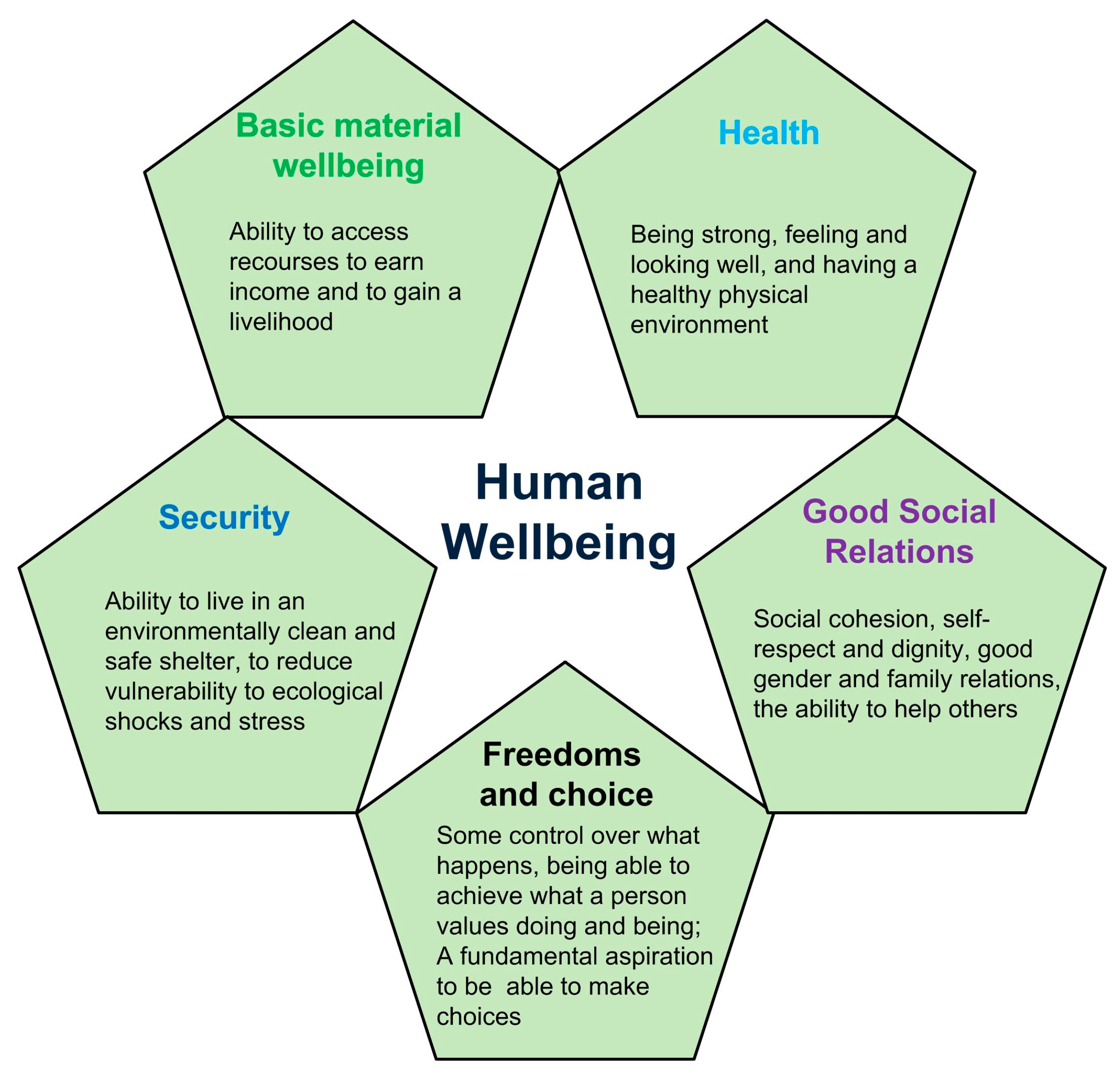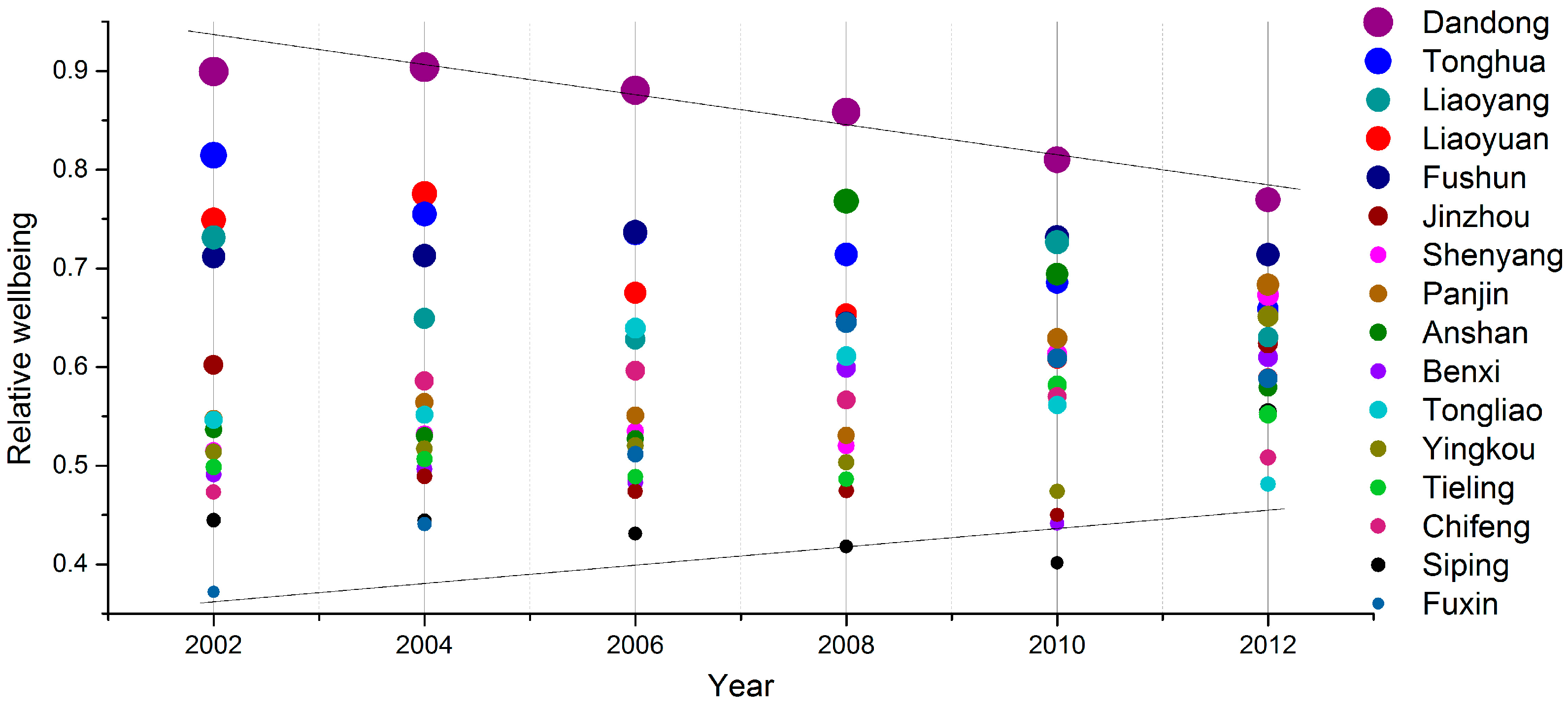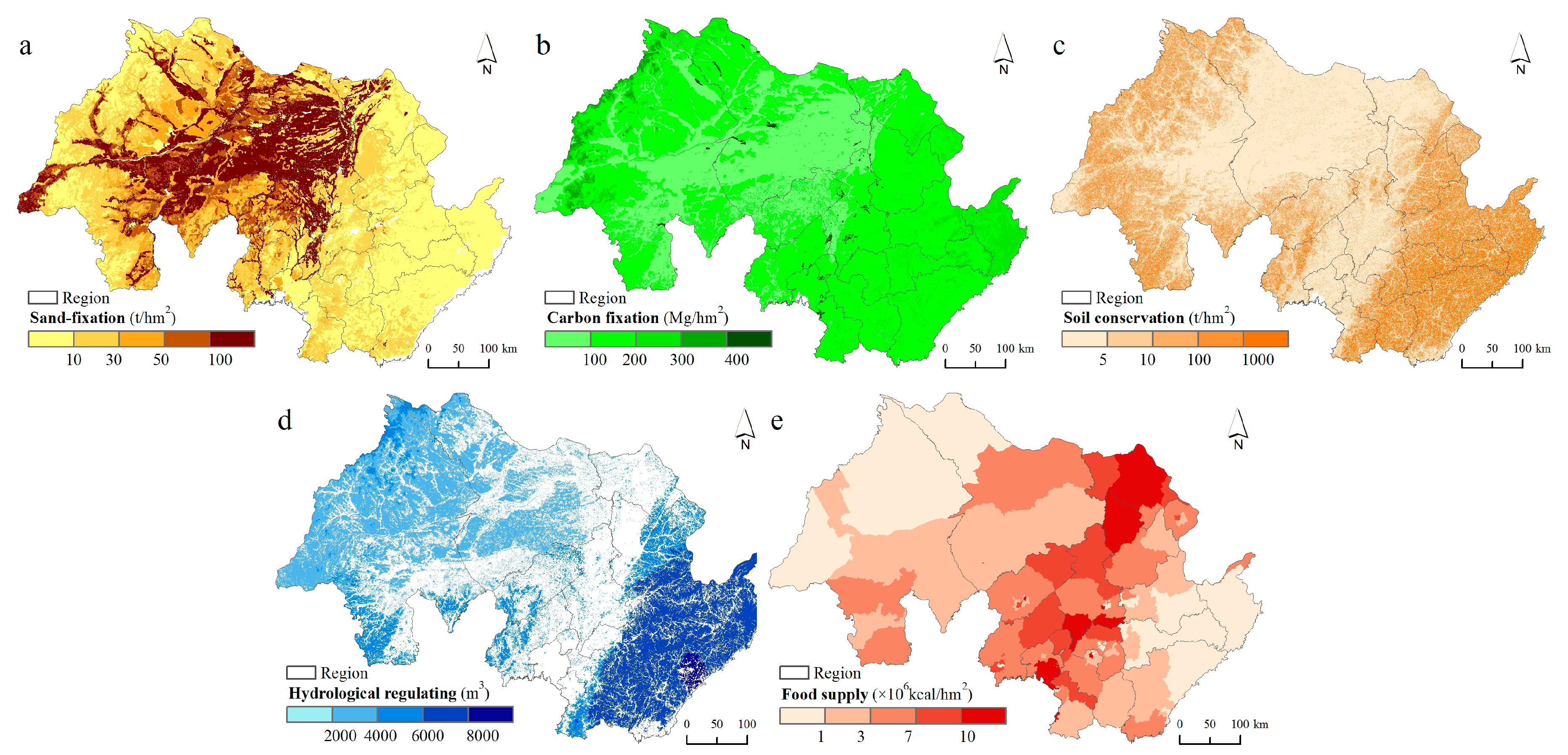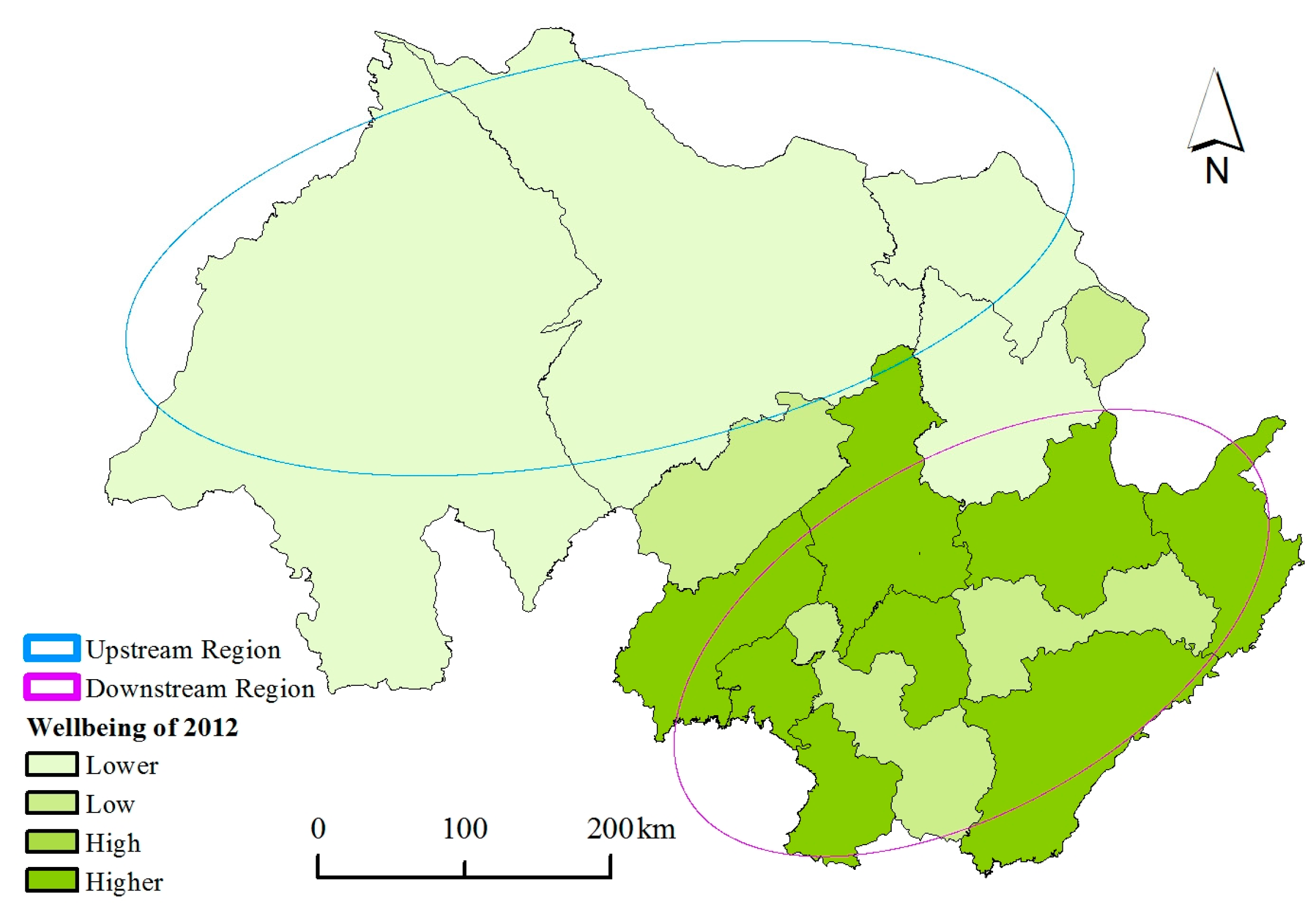Interrelations of Ecosystem Services and Rural Population Wellbeing in an Ecologically-Fragile Area in North China
Abstract
:1. Introduction
2. Interactions of Ecosystem Services and Human Wellbeing
2.1. Human Wellbeing
2.2. Ecosystem Services and Human Wellbeing
3. Materials and Methods
3.1. Study Region
3.2. Rural Population Wellbeing
3.3. Ecosystem Service
4. Results
4.1. Spatial Distribution and Change of Rural Population Wellbeing
4.2. Spatial Distribution of Ecosystem Service
4.3. Interrelations of Ecosystem Service and Rural Population Wellbeing
5. Discussion
6. Conclusions
Acknowledgments
Author Contributions
Conflicts of Interest
Appendix A
| Region | Carbon Fixation | Food Supply | Soil Conservation | Sand Fixation | Hydrological Adjustment | |||||
|---|---|---|---|---|---|---|---|---|---|---|
| (Mg/hm2) | (×106 kcal/hm2) | (t/hm2) | (t/hm2) | (m3) | ||||||
| Year | 2002 | 2012 | 2002 | 2012 | 2002 | 2012 | 2002 | 2012 | 2002 | 2012 |
| Chifeng | 112.66 | 112.60 | 0.44 | 1.12 | 75.74 | 75.78 | 44.37 | 49.21 | 3174.07 | 3173.04 |
| Tongliao | 78.90 | 78.91 | 1.01 | 2.54 | 12.22 | 12.33 | 71.36 | 82.22 | 2903.80 | 2901.50 |
| Siping | 129.08 | 129.07 | 4.47 | 11.54 | 19.75 | 19.87 | 24.86 | 26.90 | 4532.35 | 4555.86 |
| Liaoyuan | 170.50 | 170.46 | 3.45 | 4.60 | 102.27 | 102.62 | 3.17 | 3.20 | 5465.34 | 5447.40 |
| Fuxin | 94.40 | 94.37 | 1.35 | 6.89 | 49.03 | 50.47 | 73.58 | 79.81 | 4110.86 | 4106.79 |
| Shenyang | 120.72 | 120.46 | 4.47 | 8.01 | 17.90 | 18.23 | 40.45 | 41.69 | 5026.69 | 4997.70 |
| Tieling | 143.62 | 143.52 | 3.67 | 7.80 | 161.43 | 161.60 | 12.91 | 13.11 | 5699.61 | 5687.85 |
| Jinzhou | 134.10 | 134.07 | 3.70 | 6.60 | 88.13 | 89.02 | 31.37 | 32.92 | 4493.54 | 4487.04 |
| Fushun | 174.84 | 174.77 | 0.93 | 1.21 | 542.93 | 542.16 | 5.64 | 5.48 | 6512.64 | 6498.23 |
| Tonghua | 223.41 | 223.42 | 0.75 | 0.80 | 861.83 | 860.97 | 0.95 | 0.95 | 6969.17 | 6968.49 |
| Benxi | 181.37 | 181.27 | 0.69 | 0.88 | 1085.79 | 1085.03 | 3.28 | 3.21 | 6933.47 | 6918.76 |
| Dandong | 169.07 | 168.93 | 1.12 | 1.49 | 1049.96 | 1047.82 | 6.99 | 6.99 | 7480.01 | 7474.94 |
| Yingkou | 157.19 | 156.94 | 2.34 | 4.10 | 425.18 | 426.01 | 10.96 | 10.86 | 5869.72 | 5857.25 |
| Anshan | 158.54 | 158.43 | 3.31 | 4.75 | 485.63 | 485.31 | 14.76 | 14.74 | 6453.68 | 6451.75 |
| Liaoyang | 149.24 | 149.13 | 3.72 | 4.24 | 365.81 | 365.94 | 7.886 | 7.79 | 6326.57 | 6307.43 |
| Panjin | 122.78 | 122.75 | 4.73 | 7.52 | 2.64 | 2.64 | 9.92 | 9.71 | 4226.01 | 4231.48 |
References
- Wang, D.S.; Zhang, H.; Ouyang, Z.Y. Ecosystem services supply and consumption and their relationships with human well-being. Chin. J. Appl. Ecol. 2013, 24, 1747–1753, (In Chinese with English Abstract). [Google Scholar]
- Summers, J.K.; Smith, L.M.; Case, J.L.; Linthurst, R.A. A review of the elements of human well-being with an emphasis on the contribution of ecosystem services. AMBIO 2012, 41, 327–340. [Google Scholar] [CrossRef] [PubMed]
- Sandhu, H.; Sandhu, S. Linking ecosystem services with the constituents of human well-being for poverty alleviation in eastern Himalayas. Ecol. Econ. 2014, 107, 65–75. [Google Scholar] [CrossRef]
- Niu, W.Y. The discriminatory index with regard to the weakness, overlapness, and breadth of Ecotone. Acta. Ecol. Sin. 1989, 9, 97–99, (In Chinese with English Abstract). [Google Scholar]
- Liu, H.J.; Zhou, C.X.; Gao, J.X. Location determination of ecologically vulnerable regions in China. Biodivers. Sci. 2015, 23, 725–732, (In Chinese with English Abstract). [Google Scholar] [CrossRef]
- Tian, Y.P.; Chang, H. Bibliometric analysis of research progress on ecological vulnerability in China. Acta. Geogr. Sin. 2012, 67, 1515–1525, (In Chinese with English Abstract). [Google Scholar]
- Zhao, H.L.; Zhao, X.Y.; Zhang, H.T. Causes, Processes and Countermeasures of Desertif ication in the Interlocked Agro-pasturing Area of North China. J. Desert Res. 2000, 20, 22–28, (In Chinese with English Abstract). [Google Scholar]
- Smith, L.; Clay, P.M. Measuring Subjective and Objective Well-being: Analyses from Five Marine Commercial Fisheries. Hum. Organ. 2010, 2, 158–168. [Google Scholar] [CrossRef]
- Jordan, S.J.; Hayes, S.E.; Yoskowitz, D.; Smith, L.M.; Summers, J.K.; Russell, M.; Benson, W.H. Accounting for natural resources and environmental sustainability: Linking ecosystem services to human well-being. Environ. Sci. Technol. 2010, 44, 1530–1536. [Google Scholar] [CrossRef] [PubMed]
- United Nations Development Programme (UNDP). Human Development Report 1990; Oxford University Press: New York, NY, USA, 1990. [Google Scholar]
- Cummins, R.A.; Eckersley, R.; Pallant, J.; Van Vugt, J.; Misajon, R. Developing a National Index of Subjective Wellbeing: The Australian Unity Wellbeing Index. Soc. Indic. Res. 2003, 2, 159–190. [Google Scholar] [CrossRef]
- Clark, D.A. Sen’s Capability Approach and the Many Spaces of Human Well-being. J. Dev. Stud. 2005, 8, 1339–1368. [Google Scholar] [CrossRef]
- Sen, A. Development as Freedom; Oxford University Press: Oxford, UK, 2001. [Google Scholar]
- Reid, W.V.; Mooney, H.A.; Cropper, A.; Capistrano, D.; Carpenter, S.R.; Chopra, K.; Dasgupta, P.; Dietz, T.; Duraiappah, A.K.; Hassan, R.; et al. Millennium Ecosystem Assessment—Ecosystems and Human Well-being: Synthesis; Island Press: Washington, DC, USA, 2005. [Google Scholar]
- Costanza, R.; Fisher, B.; Ali, S.; Beer, C.; Bond, L.; Boumans, R.; Danigelis, N.L.; Dickinson, J.; Elliott, C.; Farley, J.; et al. Quality of Life: An Approach Integrating Opportunities, Human Needs, and Subjective Well-being. Ecol. Econ. 2007, 61, 267–276. [Google Scholar] [CrossRef]
- United Nations Development Programme. Human Development Report—International Cooperation at a Crossroads: Aid, Trade and Security in an Unequal World; Oxford University Press: New York, NY, USA, 2005. [Google Scholar]
- Li, Y.; Li, S.C.; Gao, Y.; Wang, Y. Ecosystem services and hierarchic human well-being: Concepts and service classification framework. Acta. Geogr. Sin. 2013, 68, 1038–1047, (In Chinese with English Abstract). [Google Scholar]
- Maslow, A.H. The Instinctoid Nature of Basic Needs. J. Personal. 1954, 22, 326–347. [Google Scholar] [CrossRef]
- Daw, T.; Brown, K.; Rosendo, S.; Pomeroy, R. Applying the ecosystem services concept to poverty alleviation: The need to disaggregate human well-being. Environ. Conserv. 2011, 38, 370–379. [Google Scholar] [CrossRef]
- UNEP. Water Issue, 11th ed.; DFID: London, UK, 1998. [Google Scholar]
- Diener, E. A value based index for measuring national quality of life. Soc. Indic. Res. 1995, 36, 107–127. [Google Scholar] [CrossRef]
- Prescott-Allen, R. The Wellbeing of Nations; Island Press: Washington, DC, USA, 2001. [Google Scholar]
- Shah, H.; Peck, J. Well-Being and the Environment: Achieving One Planet Living and Quality of Life; New Economics Foundation: London, UK, 2005. [Google Scholar]
- Vemuri, A.W.; Costanza, R. The role of human, social, built, and natural capital in explaining life satisfaction at the country level: Toward a National Well-Being Index (NWI). Ecol. Econ. 2006, 58, 119–133. [Google Scholar] [CrossRef]
- Yang, L.; Zhen, L.; Li, F.; Wei, Y.J. Impacts of Ecosystem Services Change on Human Well-Being in the Loess Plateau. Resour. Sci. 2010, 32, 849–855, (In Chinese with English Abstract). [Google Scholar]
- Daily, G.C. Nature’s Services: Societal Dependence on Natural Ecosystem; Island Press: Washington, DC, USA, 1997. [Google Scholar]
- Ouyang, Z.Y.; Wang, R.S.; Zhao, J.Z. Ecosystem services and their economic valuation. Chin. J. Appl. Ecol. 1999, 10, 635–640. (In Chinese) [Google Scholar]
- Li, W.H.; Zhang, B.; Xie, G.D. Research on ecosystem services in China: Progress and perspectives. J. Nat. Resour. 2009, 24, 1–10. (In Chinese) [Google Scholar]
- Hains, Y.R.; Potschin, M. The Links between Biodiversity, Ecosystem Services and Human Well-Being. In Ecosystem Ecology: A New Systhsis; Raffaelli, D., Frid, C., Eds.; Cambridge University Press: Cambridge, UK, 2010. [Google Scholar]
- Costanza, R.; D’Arge, R.; De Groot, R.; Farber, S.; Grasso, M.; Hannon, B.; Limburg, K.; Naeem, S.; O’Neill, R.V.; Paruelo, J.; et al. The value of the world’s ecosystem services and natural capital. Nature 1997, 387, 253–260. [Google Scholar] [CrossRef]
- Zheng, H.; Robinson, B.E.; Liang, Y.C.; Polasky, S.; Ma, D.C.; Wang, F.C.; Ruckelshaus, M.; Ouyang, Z.Y.; Daily, G.C. Benefits, costs, and livelihood implications of a regional payment for ecosystem service program. Proc. Natl. Acad. Sci. USA 2013, 110, 16681–16686. [Google Scholar] [CrossRef] [PubMed]
- Smith, L.M.; Case, J.L.; Smith, H.M.; Harwell, L.C.; Summers, J.K. Relating ecosystem services to domains of human well-being: Foundation for a US index. Ecol. Indic. 2012, 28, 79–90. [Google Scholar] [CrossRef]
- Costanza, R.; Norton, B.G.; Haskell, B.D. Toward an Operational Definition of Health. In Ecosystem Health-New Goals for Environmental Management; Island Press: Washington, DC, USA, 1992. [Google Scholar]
- Yan, Y.; Zhao, C.; Wang, C.; Shan, P.; Zhang, Y.; Wu, G. Ecosystem health assessment of the Liao River Basin upstream region based on ecosystem services. Acta. Ecol. Sin. 2016, 36, 294–300. [Google Scholar] [CrossRef]
- Mirzabaev, A.; Ahmed, M.; Werner, J.; Pender, J.; Louhaichi, M. Rangelands of Central Asia: Challenges and opportunities. J. Arid. Land 2016, 8, 93–108. [Google Scholar] [CrossRef]
- Huang, L.; Liu, J.Y.; Shao, Q.Q.; Deng, X.Z. Temporal and spatial patterns of carbon sequestration services for primary terrestrial ecosystems in China between 1900 and 2030. Acta. Ecol. Sin. 2016, 36, 3891–3902, (In Chinese with English Abstract). [Google Scholar]
- Ouyang, Z.Y.; Zheng, H.; Xiao, Y.; Polasky, S.; Liu, J.G.; Xu, W.H.; Wang, Q.; Zhang, L.; Xiao, Y.; Rao, E.M.; et al. Improvements in ecosystem services from investments in natural capital. Science 2016, 352, 1455–1459. [Google Scholar] [CrossRef] [PubMed]
- Ran, S.H.; Zeng, S.Y.; Xue, J.Y. Assessment and Control of Moderate Economic Exploitation in Regions with Vulnerable Ecosystem. J. Arid. Land Resour. Environ. 2003, 16, 1–6, (In Chinese with English Abstract). [Google Scholar]
- Cao, X.S.; Li, P.; Yan, T.Z.; Han, G.H. The land reclamation and its influence on environment in West Liaohe Basin from 1902 to 1990. Geogr. Res. 2005, 24, 889–898, (In Chinese with English Abstract). [Google Scholar]






| Layer | Indicator | Unit | |
|---|---|---|---|
| Rural population wellbeing (RPWB) | Economic wellbeing (ECWB) | Per capita net income | Yuan |
| Environmental wellbeing (ENWB) | Water environmental quality | - | |
| Social wellbeing (SWB) | Per capita living space | km2 | |
| Rural and urban income ratio | - |
| Indicator | Unit | Issue | Modeling Method | |
|---|---|---|---|---|
| ES | Carbon fixation | Mg/hm2 | climate regulation and vegetation protection | Soil organic carbon sequestration of vegetation and soil |
| Food supply | kcal/hm2 | Production capacity | Statistical yearbook | |
| Soil conservation | t/hm2 | Water erosion | Universal soil loss equation (USLE) | |
| Sand fixation | t/hm2 | Wind erosion | Revision wind erosion equation (RWEQ) | |
| Hydrological adjustment | m3 | Regulate water resource | Reserves of precipitation resources |
| Spearman Correlation | RPWB | Net Income | Water Environment | Rural-Urban Income Ratio | Living Space |
|---|---|---|---|---|---|
| Carbon fixation | 0.529 ** | 0.096 | 0.409 * | 0.402 * | −0.221 |
| Food supply | 0.009 | 0.479 ** | 0.076 | −0.155 | 0.647 ** |
| Soil conservation | 0.422 * | 0.122 | 0.545 ** | 0.338 | −0.169 |
| Sand fixation | −0.616 ** | −0.117 | −0.306 | −0.503 ** | 0.179 |
| Hydrological adjustment | 0.560 ** | 0.195 | 0.642 ** | 0.353 * | −0.124 |
© 2017 by the authors. Licensee MDPI, Basel, Switzerland. This article is an open access article distributed under the terms and conditions of the Creative Commons Attribution (CC BY) license (http://creativecommons.org/licenses/by/4.0/).
Share and Cite
Yan, Y.; Zhao, C.; Quan, Y.; Lu, H.; Rong, Y.; Wu, G. Interrelations of Ecosystem Services and Rural Population Wellbeing in an Ecologically-Fragile Area in North China. Sustainability 2017, 9, 709. https://doi.org/10.3390/su9050709
Yan Y, Zhao C, Quan Y, Lu H, Rong Y, Wu G. Interrelations of Ecosystem Services and Rural Population Wellbeing in an Ecologically-Fragile Area in North China. Sustainability. 2017; 9(5):709. https://doi.org/10.3390/su9050709
Chicago/Turabian StyleYan, Yan, Chunli Zhao, Yuan Quan, Huiting Lu, Yi Rong, and Gang Wu. 2017. "Interrelations of Ecosystem Services and Rural Population Wellbeing in an Ecologically-Fragile Area in North China" Sustainability 9, no. 5: 709. https://doi.org/10.3390/su9050709






